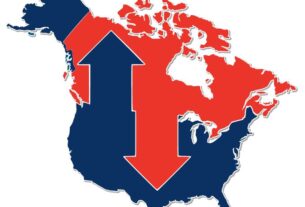Not surprisingly, the Liberal’s new leader, Mark Carney, has called the federal election for April 28. The Liberal’s sense is that they can win.
At the end of January Poilievre and the Conservatives seemed to be coasting to a landslide victory. Two months later it is now the Liberals who appear to be heading to a majority government. This enormous shift shows the volatility of Canadian society.
Poilievre’s crisis
Poilievre’s entire strategy and approach has been shredded in the last two months. He built his campaign on Canada is broken, “Axe the Tax” and being anti-Trudeau. Now all of this is out of touch with the mood in society.
Trump’s multiple tariffs and constant threats to take over Canada as the 51st state has provoked a wave of Canadian nationalism. Trudeau resigning and the crowning of Carney, a multimillionaire banker, as the Liberal’s new leader has robbed Poilievre of his anti-Trudeau attacks. Carney’s first act as new prime minister was to axe the carbon tax. The tax is gone.
How can Poilievre argue to “defend Canada” when “Canada is broken?” Now he is trying to argue for “Canada First,” a movement that harkens back to 1868 Canadian nationalist movement that promoted British Protestantism as central to Canada’s identity and whose founders were opponents of Louis Riel.
Adding to Poilievre’s woes is the sharp split between the two most important conservative provincial premiers. Doug Ford of Ontario is belligerently fighting Trump tariff for tariff, arguing to use every economic tool from tariffs on US imports to either surcharging or restricting exports of energy to the US.
Danielle Smith of Alberta is all for appeasement. She claimed that Poilievre was “very much in sync” with Trump and asked Trump to pause the tariffs, as they would help the Liberals, until after the election. She shared a platform and had a “great time” with Ben Shapiro, who supports Canada becoming part of the US, but as the “Puerto Rico” of the north — a colony without the right to vote in US elections. Shapiro previously had stated that Canada is a “silly country.” They discussed how to get Canada to elect “solid allies” of Trump. The event was organized by the reactionary PragerU.
China has also imposed tariffs on Canadian canola, pork and seafood it says is in retaliation for tariffs on Chinese electric vehicles. This ongoing trade conflict could become a second trade war alongside the one with the US.
The Conservatives’ success until two months ago was because they appeared to share the anger of many Canadians at high prices, stagnant wages and unaffordable housing. That anger will return in a future election and probably propel a right-populist party into government.
NDP risks being irrelevant
The surge in support for the Liberals has been at the expense of the NDP and Bloc as well as the Conservatives. Some recent opinion polls have the NDP reduced to less than 10 seats, their worst result in over 30 years. For 2.5 years the NDP supported the minority Liberal government and are seen as the tail of the Liberal dog. Now, many Canadians are not even listening to what the NDP says. Socialist Alternative warned at the time of the Liberal-NDP agreement that the NDP risked paying a high price.
While the NDP makes valid criticisms of the Liberals’ and Conservatives’ program for big business, their policies are only moderately better than these. There are no plans for a major increase in taxes on the ultra rich or on the super profits of big business. The NDP does not call for the public ownership of corporations threatening to close or fire workers. There is no plan for a publicly driven industrial program to counter a trade war.
Liberals and Tories both back big business
The corporations and their think tanks have seized on the trade war to push their long-held goals. They want tax cuts for big business although there is no evidence that tax cuts boost investment; Harper tried that, and it failed. At the same time, despite the evidence, they want more subsidies. They want a major expansion of extractive industries and a removal of environmental and social regulations. There is a clamour to build pipelines, to quote Danielle Smith “in every direction,” west with another line to Pacific Ocean, east to the Atlantic Ocean, north to the Arctic (!) and presumably south, sending more oil to the US. Both the Liberals and Conservatives advocate for a major expansion of nuclear power. They agree on a big increase in military spending, while cutting federal services.
Liberals and Tories say they will increase house building. However, their policies are more bribes and handouts to the developers — the same failed approach of the last few decades that created the housing crisis. Perhaps the only new initiative would be to cut the regulations that protect health and safety and the environment. Poilievre is a landlord. Carney was the chair of Brookfield, which owns Brookfield Properties, a multibillion-dollar corporation that has residential and student rental properties across Canada and the US. Don’t expect renters’ rights from either of these parties.
The Liberals’ and Conservatives’ “Team Canada” would be a bosses’ team approach. The next government could very likely face higher inflation, and a world recession or even a 1930s-style depression. The response of government and bosses will be to try to make the workers pay. All the talk of “being in this together” will disappear as it did in COVID. It is likely that workers going on strike or land defenders protecting the environment will be branded as traitors.
It is a dangerous illusion to think there is class unity between the bosses and workers. Auto workers in Canada, the US and Mexico will all be hit by the tariffs. Yet the auto workers’ union leaders have illusions of unity between bosses and workers. Lana Payne, head of Unifor, claimed Trump had “united an entire nation to fight to defend every last job in this country.” Unifor Local 222 President Gray said Carney should target cars made in the US. Sean Fain, head of US Autoworkers, supports the tariffs. Trump will at some stage attack unions as will Carney and Canadian bosses. Workers divided are good news for the bosses. Rather than union leaders lining up with the bosses in their country, they should be reaching across the borders to build solidarity among workers.
A workers’ program for trade wars
Workers will face either a Conservative or Liberal government in May. While there are differences, with Poilievre being more reactionary, the two parties agree on much. The NDP is the best party on offer but has a weak program and generates little enthusiasm.
The working class needs its own program, especially during trade wars, and a campaign to fight for it, regardless of who is the next prime minister. Central to the program is to provide multiple benefits including ensuring good jobs, meeting workers’ needs and protecting the environment. Unions and workers should start preparing now to meet the coming attacks, higher prices, a recession and job cuts.
Fundamental is protecting jobs. If companies introduce layoffs, close factories or try to remove machinery the workplace should be occupied with demands that it be taken into public ownership. Government should provide wage protection.
If the bosses say there is no demand for what is made, such as cars, the factory should be converted to useful production, such as light rail cars for urban transit. A Cadillac car plant was converted to a tank factory during World War II in less than two months. Then most of the capitalist class was united in its war effort. While Canada faces trade wars, the bosses are more interested in protecting their profits. It will take workers’ struggle to win a workers’ program.
There has been much talk of building oil pipelines. However, a pipeline costs billions of dollars to build (Trans Mountain cost $35 billion), takes years to complete (Trans Mountain took over a decade), locks in burning fossil fuels for decades and can only ship one commodity. Railways are far more flexible as they can carry a wide range of goods and connect most of Canada. Yet because they have been starved of investment, Canadian freight trains travel at an average speed of 33 kilometres an hour, compared to 120 kilometres an hour in mountainous Switzerland. Passenger rail hardly exists outside of the Toronto-Montreal corridor. CN and CPR should be taken into public ownership, and the government should invest major funds to upgrade the track and bed, dual track the lines wherever possible, electrify parts of the system and extend the lines. This would allow much more freight to move in all directions and return passenger rail to Canada — all with less environmental damage while providing good jobs.
Similar programs should be launched to build public housing and upgrade existing housing, greatly expand urban public transit and accelerate the provision of renewable energy. These and many more possibilities exist to provide good jobs, meet workers’ needs and protect the environment. A key barrier to this happening is the private ownership of society’s wealth, controlled by a tiny minority for their own gain.
Rather than cut taxes for the rich individuals and corporations as the bosses want, these taxes should be increased to fund a workers’ program
Solidarity forever
Unions representing 300,000 workers in Alberta have agreed a “Solidarity Pact” to combat anticipated attacks on workers’ pay and rights. Imagine if all the unions in Canada, representing 4 million workers, formed a solidarity pact based on the principle that “an injury to one is an injury to all” to fight for jobs and workers’ rights. Such a pact could start by having discussions in workplaces and union locals and build to public rallies and demonstrations. It could also reach out to workers who will be hit by tariffs in the US and Mexico. Actions would include solidarity with any group of workers whose jobs are threatened, whether in the public or private sector. Action could escalate to solidarity strikes demanding jobs and public ownership of corporations closing or laying off workers. A solidarity pact would also put pressure on politicians of all stripes to act on behalf of workers.
Such a movement might not win every demand or every struggle, but it would fundamentally shift the power toward workers and change the conversations across the country. It might result in a struggle to return the NDP to its socialists roots, or if the party’s bureaucracy refuses to budge, lead to the formation of a new semi-mass party that stands for the interests of the working class.
Socialist Alternative is committed to fighting for a workers’ program to deal with the trade wars. If you agree, contact us about joining.




